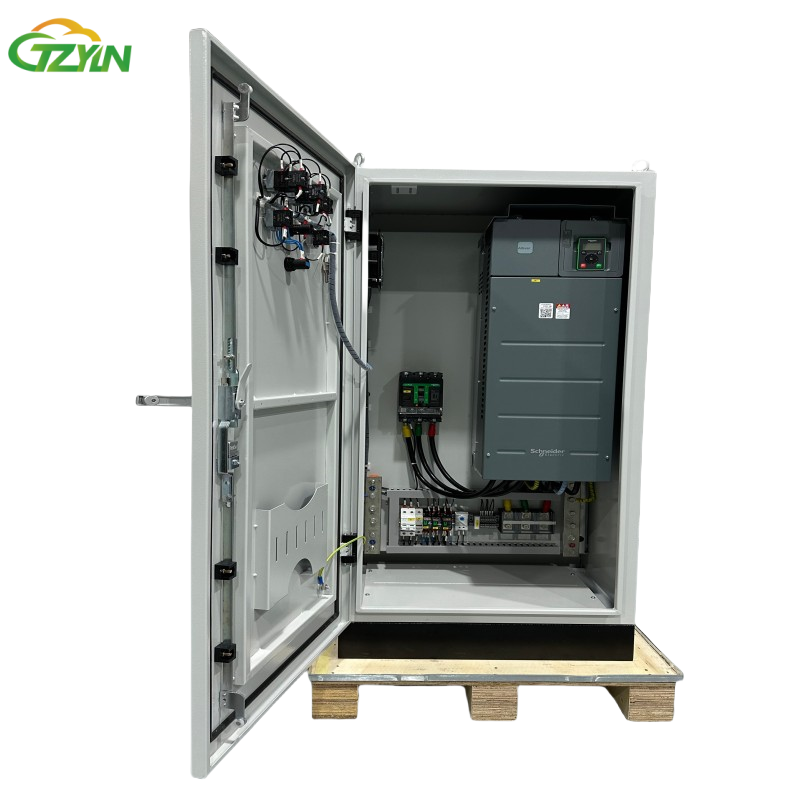Frequency conversion cabinets play a crucial role in modern power distribution. They ensure efficient power management by adjusting electrical frequencies to match the requirements of various systems. These cabinets optimize the performance of motors and other devices, which reduces energy consumption and operational costs. Their design enhances compatibility with diverse electrical equipment, making them indispensable in industries that demand precision and reliability. By supporting energy efficiency and sustainability, frequency conversion cabinets contribute significantly to advancing modern power systems.
What Are Frequency Conversion Cabinets?
Definition and Purpose
Frequency conversion cabinets are specialized electrical enclosures designed to regulate and adapt the frequency of power supplied to various systems. They serve as a critical component in modern power distribution by ensuring that electrical devices operate efficiently and reliably. These cabinets adjust the frequency of the electrical current to match the specific requirements of connected equipment. This capability enhances energy efficiency and reduces wear on machinery, making them indispensable in industries that rely on precision and performance.
The primary purpose of frequency conversion cabinets is to optimize power management. By controlling the speed and torque of motors, they help reduce energy consumption and improve overall system performance. Their ability to adapt power supply frequencies ensures compatibility with a wide range of electrical devices, from industrial machinery to renewable energy systems. This adaptability makes them a cornerstone of modern energy solutions.
Key Components
Frequency conversion cabinets consist of several essential components that work together to achieve efficient power regulation. Each component plays a unique role in ensuring the cabinet's functionality and reliability.
Power Converters
Power converters form the core of frequency conversion cabinets. These devices transform electrical energy from one frequency to another, enabling compatibility with various systems. They ensure that motors and other equipment receive the precise frequency required for optimal operation. Power converters also help minimize energy losses during the conversion process, contributing to cost savings and sustainability.
Control Systems
Control systems manage the operation of frequency conversion cabinets. They monitor and adjust the frequency and voltage of the electrical output based on the needs of connected devices. Advanced control systems often include programmable logic controllers (PLCs) or microprocessors, which allow for precise adjustments and automation. These systems enhance the cabinet's efficiency and ensure seamless integration with other components in the power distribution network.
Cooling Mechanisms
Cooling mechanisms prevent overheating within frequency conversion cabinets. These systems maintain a stable operating temperature for internal components, ensuring their longevity and reliability. Common cooling methods include air cooling, liquid cooling, and heat sinks. Proper cooling is essential for maintaining the performance and safety of the cabinet, especially in high-demand applications.
How Frequency Conversion Cabinets Work
Frequency conversion cabinets operate by converting the input electrical power into a form that matches the requirements of the connected equipment. The process begins with the power converter, which adjusts the frequency and voltage of the incoming current. The control system continuously monitors the output and makes real-time adjustments to ensure optimal performance. Cooling mechanisms regulate the temperature of the internal components, preventing damage and maintaining efficiency.
These cabinets often use variable frequency drives (VFDs) to control the speed and torque of motors. VFDs allow for smooth acceleration and deceleration, reducing mechanical stress and extending the lifespan of equipment. By providing precise control over power delivery, frequency conversion cabinets enhance the performance and reliability of electrical systems across various applications.
Key Functions of Frequency Conversion Cabinets
Energy Efficiency and Cost Reduction
Frequency conversion cabinets play a pivotal role in improving energy efficiency. By regulating the frequency and voltage of electrical power, they ensure that motors and other devices operate at optimal levels. This precise control minimizes energy wastage, which directly reduces electricity consumption. Industries that rely on heavy machinery benefit significantly from these cabinets, as they help lower operational costs over time.
The ability of these cabinets to adjust power delivery also prevents unnecessary energy spikes. This feature not only conserves energy but also protects equipment from potential damage caused by power surges. Businesses that integrate frequency conversion cabinets into their systems often experience a noticeable decrease in utility expenses, making these cabinets a cost-effective solution for modern power distribution.
Soft-Start Capabilities for Motors
Soft-start capabilities represent another essential function of frequency conversion cabinets. When motors start abruptly, they often experience mechanical stress and high inrush currents. These conditions can lead to premature wear and tear or even equipment failure. Frequency conversion cabinets address this issue by gradually increasing the motor's speed during startup.
This controlled acceleration reduces mechanical strain and extends the lifespan of the motor. It also enhances safety by preventing sudden jolts or vibrations that could disrupt operations. Industries that depend on large-scale machinery, such as manufacturing and construction, rely on this feature to maintain smooth and reliable performance.
Simplified System Control and Frequency Adaptation
Frequency conversion cabinets simplify system control by offering precise adjustments to power output. Advanced control systems within these cabinets allow operators to monitor and modify frequency settings with ease. This level of control ensures that connected devices receive the exact power specifications required for efficient operation.
The ability to adapt frequencies also enhances compatibility with a wide range of electrical equipment. Whether used in industrial processes, renewable energy systems, or commercial applications, these cabinets ensure seamless integration across diverse systems. Their adaptability makes them indispensable in environments where multiple devices with varying power requirements operate simultaneously.
Enhanced Compatibility with Electrical Equipment
Frequency conversion cabinets enhance the compatibility of electrical systems by adapting power supply frequencies to meet the specific requirements of connected devices. This capability ensures seamless integration across a wide range of equipment, regardless of their operational specifications. Industries often face challenges when using machinery or devices that require different power frequencies. These cabinets eliminate such issues by providing precise frequency adjustments, enabling diverse equipment to function efficiently within the same system.
Modern electrical systems frequently incorporate equipment from various manufacturers, each with unique power demands. Frequency conversion cabinets bridge these differences by standardizing the power output to match the needs of each device. This feature not only improves system performance but also reduces the risk of equipment malfunction caused by incompatible power supplies. Operators can rely on these cabinets to maintain consistent and reliable performance across all connected components.
The adaptability of frequency conversion cabinets proves invaluable in environments where multiple devices operate simultaneously. For instance, industrial facilities often use machinery with varying speed and torque requirements. These cabinets ensure that each machine receives the appropriate power frequency, optimizing its performance without compromising the efficiency of the overall system. This level of compatibility minimizes downtime and enhances productivity.
In addition to industrial applications, frequency conversion cabinets play a critical role in renewable energy systems. Wind turbines and solar power systems often generate electricity at variable frequencies. These cabinets adjust the output to align with grid requirements, ensuring smooth integration and efficient energy distribution. Their ability to adapt to fluctuating power inputs makes them essential for maintaining stability in renewable energy operations.
By enhancing compatibility with electrical equipment, frequency conversion cabinets contribute to the longevity and reliability of devices. They reduce the strain caused by mismatched power supplies, which helps prevent wear and tear. This capability not only extends the lifespan of equipment but also lowers maintenance costs, making these cabinets a cost-effective solution for modern power distribution.
Benefits of Frequency Conversion Cabinets
Reduced Mechanical Wear and Tear
Frequency conversion cabinets significantly reduce mechanical wear and tear on equipment. By providing precise control over motor speed and torque, these cabinets eliminate the abrupt starts and stops that often cause excessive strain on machinery. Motors and other mechanical components operate more smoothly, minimizing the risk of damage caused by sudden jolts or vibrations.
The soft-start capabilities of these cabinets play a crucial role in reducing stress on mechanical systems. Gradual acceleration and deceleration prevent unnecessary friction and heat generation, which are common culprits of premature equipment failure. Industries that rely on heavy machinery, such as manufacturing and construction, benefit greatly from this feature. The reduced mechanical stress translates into fewer breakdowns and lower maintenance costs, ensuring uninterrupted operations.
Improved System Reliability and Performance
Frequency conversion cabinets enhance the reliability and performance of power distribution systems. By regulating the frequency and voltage of electrical power, they ensure that connected devices receive consistent and stable energy. This stability prevents fluctuations that could disrupt operations or damage sensitive equipment.
Advanced control systems within these cabinets allow for real-time monitoring and adjustments. Operators can fine-tune power delivery to match the specific requirements of each device, optimizing performance across the entire system. This level of precision reduces the likelihood of malfunctions and ensures that all components work harmoniously.
Industries that demand high levels of reliability, such as healthcare and data centers, rely on frequency conversion cabinets to maintain continuous operations. These cabinets safeguard critical systems against power interruptions and inefficiencies, providing peace of mind and operational excellence.
Extended Equipment Lifespan
Frequency conversion cabinets contribute to extending the lifespan of electrical and mechanical equipment. By delivering power in a controlled and efficient manner, they reduce the wear and tear that often shortens the operational life of devices. Motors, in particular, benefit from the smooth operation enabled by these cabinets, as they experience less stress during startup and operation.
The cooling mechanisms integrated into frequency conversion cabinets also play a vital role in preserving equipment longevity. By maintaining optimal operating temperatures, these systems prevent overheating, which can degrade components over time. Proper temperature regulation ensures that internal parts remain functional and reliable for extended periods.
Businesses that invest in frequency conversion cabinets often see a significant return on investment through reduced replacement costs and longer intervals between maintenance cycles. The extended lifespan of equipment not only lowers expenses but also supports sustainability by reducing waste and resource consumption.
Contribution to Energy Savings and Sustainability
Frequency conversion cabinets play a vital role in promoting energy savings and sustainability. By optimizing power delivery, they minimize energy waste and ensure efficient operation of electrical systems. This efficiency reduces the overall energy demand, which directly lowers greenhouse gas emissions associated with power generation. Industries and businesses that adopt these cabinets contribute to a more sustainable energy ecosystem.
These cabinets support renewable energy integration by stabilizing power outputs from sources like wind turbines and solar panels. Renewable energy systems often produce variable frequencies due to changing environmental conditions. Frequency conversion cabinets adjust these fluctuations, ensuring smooth energy distribution and compatibility with the electrical grid. This capability enhances the reliability of renewable energy systems and encourages their adoption on a larger scale.
The reduction in mechanical wear and tear achieved through these cabinets also supports sustainability. Equipment that operates efficiently and experiences less stress requires fewer replacements and repairs. This longevity decreases the consumption of raw materials and energy needed for manufacturing new components. Businesses benefit from lower maintenance costs while contributing to resource conservation.
Energy savings achieved through frequency conversion cabinets extend beyond industrial applications. Commercial buildings equipped with these systems experience reduced electricity consumption in HVAC systems, elevators, and other essential operations. This reduction not only lowers operational expenses but also aligns with global efforts to combat climate change by reducing energy footprints.
In addition to direct energy savings, these cabinets promote sustainable practices by enabling precise control over power usage. Operators can monitor and adjust energy consumption in real-time, identifying inefficiencies and implementing corrective measures. This proactive approach fosters a culture of energy responsibility, encouraging organizations to prioritize sustainability in their operations.
By integrating frequency conversion cabinets into power distribution systems, industries and businesses take a significant step toward achieving energy efficiency and environmental sustainability. These cabinets exemplify how technological advancements can address modern energy challenges while supporting long-term ecological goals.
Applications of Frequency Conversion Cabinets
Industrial Applications
Manufacturing and Production Lines
Frequency conversion cabinets play a vital role in manufacturing and production lines. These environments often require precise control over motor speeds to ensure consistent product quality. By regulating the frequency of electrical power, these cabinets enable machinery to operate at optimal speeds. This capability enhances efficiency and minimizes energy waste. Manufacturers rely on these cabinets to maintain smooth operations, reduce downtime, and improve overall productivity.
In addition, frequency conversion cabinets help streamline processes in automated production lines. They allow operators to adjust motor speeds based on specific production requirements. This flexibility ensures that equipment can handle varying workloads without compromising performance. Industries such as automotive, food processing, and electronics benefit significantly from this adaptability.
Heavy Machinery Operations
Heavy machinery operations demand robust and reliable power management solutions. Frequency conversion cabinets provide the necessary control to handle the high power requirements of heavy equipment. They ensure that motors operate smoothly, reducing mechanical stress and extending the lifespan of machinery. This feature is particularly valuable in industries like mining, construction, and steel manufacturing.
These cabinets also enhance safety in heavy machinery operations. By offering soft-start capabilities, they prevent sudden jolts that could damage equipment or pose risks to workers. The precise control over motor speed and torque ensures stable performance, even under challenging conditions. Businesses that depend on heavy machinery often integrate frequency conversion cabinets to optimize operations and minimize maintenance costs.
Commercial Applications
HVAC Systems
Heating, ventilation, and air conditioning (HVAC) systems rely on frequency conversion cabinets to achieve energy-efficient performance. These cabinets regulate the speed of fans, pumps, and compressors, ensuring that the system operates at the required capacity. This control reduces energy consumption and lowers operational costs for commercial buildings.
Frequency conversion cabinets also improve the comfort and reliability of HVAC systems. By adjusting motor speeds, they maintain consistent airflow and temperature levels. This capability minimizes wear and tear on components, extending the lifespan of the system. Commercial spaces such as office buildings, shopping malls, and hospitals benefit from the enhanced efficiency provided by these cabinets.
Elevators and Escalators
Elevators and escalators require precise speed control to ensure smooth and safe operation. Frequency conversion cabinets deliver this control by adjusting the frequency of electrical power supplied to motors. This functionality eliminates abrupt starts and stops, enhancing passenger comfort and reducing mechanical wear.
In addition to improving performance, these cabinets contribute to energy savings in vertical transportation systems. They optimize power usage based on demand, ensuring efficient operation during peak and off-peak hours. Commercial buildings, airports, and transit hubs rely on frequency conversion cabinets to maintain reliable and cost-effective elevator and escalator systems.
Renewable Energy Systems
Wind Turbines
Wind turbines generate electricity at variable frequencies due to changing wind speeds. Frequency conversion cabinets play a critical role in stabilizing this output. They adjust the frequency of the generated power to match grid requirements, ensuring seamless integration with the electrical network. This capability enhances the reliability and efficiency of wind energy systems.
These cabinets also protect wind turbines from potential damage caused by fluctuating power inputs. By regulating voltage and frequency, they ensure that the turbines operate within safe parameters. Renewable energy providers depend on frequency conversion cabinets to maximize energy production and maintain system stability.
Solar Power Systems
Solar power systems often face challenges related to variable energy generation. Frequency conversion cabinets address this issue by converting the output from solar panels into a stable and usable form. They ensure that the generated power aligns with grid standards, enabling efficient distribution and utilization.
In addition to stabilizing power output, these cabinets enhance the performance of solar inverters. They optimize energy conversion processes, reducing losses and improving overall efficiency. Solar farms and residential solar installations benefit from the reliability and adaptability provided by frequency conversion cabinets.
Transportation and Infrastructure
Rail Systems
Frequency conversion cabinets play a pivotal role in modern rail systems. These systems demand precise power management to ensure smooth and efficient operations. Frequency conversion cabinets regulate the electrical power supplied to trains, enabling seamless speed control and reducing energy waste. By optimizing the performance of traction motors, these cabinets enhance the reliability and safety of rail transportation.
Rail systems often operate under varying load conditions. Frequency conversion cabinets adapt to these changes by adjusting power delivery in real-time. This capability ensures consistent performance, even during peak hours or when trains encounter steep gradients. Operators benefit from reduced mechanical stress on equipment, which extends the lifespan of critical components and minimizes maintenance requirements.
In addition to improving operational efficiency, frequency conversion cabinets contribute to energy savings in rail systems. They enable regenerative braking, a process where trains convert kinetic energy into electrical energy during deceleration. This recovered energy can be reused within the system, reducing overall power consumption and supporting sustainability goals. Rail operators increasingly rely on these cabinets to achieve cost-effective and environmentally friendly solutions.
Airports and Seaports
Airports and seaports require robust power management systems to support their complex operations. Frequency conversion cabinets ensure the efficient distribution of electrical power across various facilities, including terminals, cargo areas, and maintenance zones. These cabinets regulate power supply frequencies, enabling compatibility with diverse equipment such as conveyor belts, cranes, and lighting systems.
In airports, frequency conversion cabinets enhance the performance of ground support equipment. They provide precise control over the operation of baggage handling systems, jet bridges, and air conditioning units. This level of control reduces energy consumption and ensures uninterrupted Service for passengers and staff. By maintaining stable power delivery, these cabinets also protect sensitive equipment from voltage fluctuations and potential damage.
Seaports benefit from frequency conversion cabinets in their heavy-duty operations. Cranes and container handling systems rely on these cabinets for smooth and efficient performance. The soft-start capabilities of frequency conversion cabinets prevent sudden jolts, reducing wear and tear on machinery. This feature enhances safety and prolongs the lifespan of critical equipment.
Both airports and seaports face increasing pressure to adopt sustainable practices. Frequency conversion cabinets support these efforts by optimizing energy usage and enabling the integration of renewable energy sources. For example, they can stabilize power outputs from solar panels or wind turbines installed at these facilities. This adaptability helps reduce carbon footprints and aligns with global sustainability initiatives.
By improving energy efficiency and operational reliability, frequency conversion cabinets have become indispensable in transportation and infrastructure. Their ability to adapt to diverse applications ensures that airports and seaports can meet the demands of modern logistics and passenger services while prioritizing sustainability and cost-effectiveness.
Frequency conversion cabinets have become essential in modern power distribution systems. They enhance energy efficiency by optimizing power delivery and ensuring reliable performance across various applications. Their adaptability allows seamless integration with diverse equipment, making them a cornerstone of efficient energy use. By reducing energy consumption and extending the lifespan of machinery, these cabinets support sustainable practices while lowering operational costs. Industries and businesses that adopt these solutions benefit from improved system reliability, reduced maintenance needs, and long-term cost savings, reinforcing their value in advancing energy management strategies.




